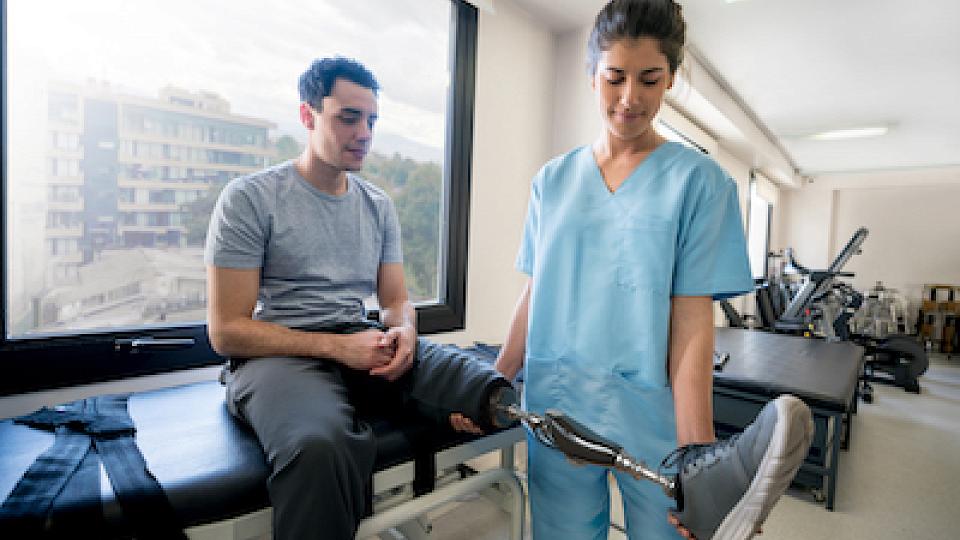
In the United States, approximately 185,000 people have an amputation each year, 507 people lose a limb each day, and 2.1 million people currently live with limb loss. By 2050, this number will reach 3.6 million, according to the Amputee Coalition.
If you're missing a limb, a device called a prosthesis may help you perform daily activities such as walking, eating, or dressing. This kind of artificial limb will allow you to function nearly as well as before you became an amputee.
If you're an amputee, you've probably already faced one of the following reasons for the loss or removal of a finger, toe, hand, foot, arm, or leg:
- Vascular disease, particularly from diabetes or peripheral artery disease
- Traumatic injuries, including motor vehicle crashes, military combat, and work-related accidents
- Tissue destruction, infection, or disease that can't be repaired or that endangers your life
- Cancer
Four to six weeks after surgery, if your wound is fully healed and the swelling has been significantly reduced, Spencer Thompson, DPT, a doctor of physical therapy and a board-certified specialist in neurological physical therapy specializing in the treatment of amputees at University of Utah Health, says you're ready to be evaluated and fitted for a prosthetic limb by a prosthetist.
Preparing for Your Prosthesis Fitting
You may need to work with your insurance company to ensure that you receive prior authorization before being fitted for your custom prosthesis.
You should select a prosthetist with whom you feel comfortable because you'll establish a lifelong relationship with them. You can find information about choosing a prosthetist by reviewing the brochure Patient and Prosthetist: Working Together for a Successful Outcome, the fact sheet Locating a Certified Prosthetist, and the Prosthetist Finder that can filter your results based on preferred location, credentials, and hours.
Fitting and Assessing Your Prosthesis
Your prosthetist will develop a treatment plan and recommend a properly fit prosthesis to match the activity level for your occupational challenges, hobbies, recreational interests, and overall health goals. This will help you get back to an independent life.
Using a variety of techniques from handcrafted custom molds to 3D scanning, your prosthetist will find the device that fits your body best. This may include making a cast of your residual limb. The resulting cast will be used to create a temporary socket to connect your residual limb to the prosthetic limb.
During the first year after surgery, your body will undergo many changes requiring frequent visits to your prosthetist to assess your replacement limb for fit and function, evaluate your residual limb pain and phantom pain, and continuously review pain management that combines medications, biomechanical evaluation, therapies, and psychological treatments.
Many prosthetics last for several years before needing to be replaced. The longevity of your prosthesis will depend on how often you wear and treat it, body changes, and activity level. During routine visits, your prosthetist will notice when parts of your prosthetic device wear out and need to be replaced.
Follow-up Training for Using Your Prosthesis
After you receive your custom-made prosthesis, you'll learn hygienic methods to keep the liner worn over your residual limb clean and how to protect your skin from being too wet or too dry. Liners fitting over your residual limb provide a barrier between your skin and the socket. Thompson encourages amputees with prosthetic limbs to try socks of various thicknesses worn over the liner to keep the socket fitting comfortably and correctly as the volume of your limb may change during the day or over time.
You'll also find out how to prevent muscle injuries in the healthy parts of your body by working with physical and occupational therapists who'll teach you how to use your new prosthesis to achieve your fitness goals. Thompson guides new patients with prosthetic limbs to realize the benefits of exercise. "It's important to continue to work on hip muscle strength and balance that leads to greater success with walking with a prosthetic," he says.
You can consult another patient who has undergone amputation to answer your questions regarding their experience. Thompson recalls working with a heart attack victim who lost his leg due to blood clots. After a year in therapy with a prosthetic leg, the amputee is thriving and volunteers as a peer mentor who talks about his positive experience to new patients in the beginning stage of their amputation.
Visit the Amputee Coalition's How to Find Support page to explore ways to connect with individuals with limb loss locally and across the country. For additional information, helpful tools, and resources, contact the National Limb Loss Resource Center at 888-267-5669 or via the form Ask an Information and Referral Specialist or U.S. Department of Veterans Affairs: Rehabilitation and Prosthetic Services.
By encouraging healthy living habits, mindfulness, mental imagery, and emotional support from family and friends, Thompson trusts that amputees with prosthetic limbs will continue to improve and return to the highest level of function and independence possible.
Craig H. Neilsen Rehabilitation Hospital
Our hospital was built for patients—of all capabilities—to interact with their surroundings in real-time. Our smart technology enables patients greater control of the space around them and their recovery. Come experience it for yourself.

Mirror Therapy to Treat Phantom Limb Pain
After an amputation, sensations or pain where the removed limb once was can significantly interfere with a person's quality of life. Colby Hansen, MD, and Spencer Thompson, DPT, discuss how consistent therapy with a simple mirror can help to alleviate the condition.





